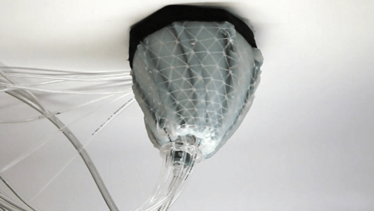Embracing Robotics with Heart
A biomimetic, pneumatic sleeve that ‘hugs’ the pericardium could support failing cardiac function

Credit: Ellen Roche
Most cardiac devices operate from within the essential organ, but a team of researchers spanning institutions across the world decided to think outside the (beating) box. Their recent paper documents a robotic device that uses actuators to squeeze the heart from outside the pericardium to support failing heart activity (1).
“We were investigating new methods in dynamic actuation, and the integration of pneumatic actuators into a soft robotics platform showed promise for achieving complex motions like that exhibited by the heart,” says Frank A. Pigula, co-corresponding author and cardiothoracic surgeon.
The device is comprised of a biomimetic elastomer matrix, embedded with pneumatic actuators that compress and twist to mimic contractions of the heart. “The actuators are based on the McKibben air muscle (pneumatic artificial muscle) and the myocardial helical band morphology,” says Pigula. “And the development of new materials and control systems in the area of soft robotics offered new opportunities.”
Designing the device was an iterative process that required in vitro and in vivo experimentation to finalize, according to Pigula. The current version of the soft cardiac sleeve has been tested on pig hearts; when cardiac output was reduced to approximately 45 percent of baseline activity, the device was able to recover the porcine heart to almost full activity (97 percent).
The team believes the cardiac sleeve could have long-term viability in sustaining cardiac strength, but further iterations will be needed. To that end, Pigula says they’re going to work on design optimization and attachment methodology, as well as other translational applications: “This technology could be suitable for a range of other assist applications (both implantable and external), and our groups will continue to explore these avenues.”
- ET Roche et al., “Soft robotic sleeve supports heart function”, Sci Transl Med, 9, eaaf3925 (2017). PMID: 28100834.
My fascination with science, gaming, and writing led to my studying biology at university, while simultaneously working as an online games journalist. After university, I travelled across Europe, working on a novel and developing a game, before finding my way to Texere. As Associate Editor, I’m evolving my loves of science and writing, while continuing to pursue my passion for gaming and creative writing in a personal capacity.















